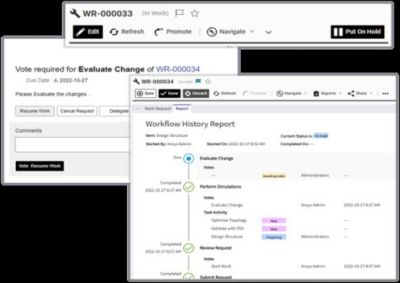Ansys博客
October 13, 2023
畅享数字浪潮:SPDM缓解数据溢出问题
从汽车、航空航天到消费类电子产品和医疗,几乎每个行业都在经历数字化转型,企业正在采用比以往任何时候都要多的工具和技术。然而,尽管采用新的工作流程是有益的,但分散在各部门的不同技术和互不相连的解决方案可能会降低生产速度,并导致组织内部部门之间产生壁垒。此外,有一个因素加剧了问题复杂性,即每个工具集都有自己的数据集。这不仅会导致信息过载,而且还会产生更多的不连续性和流程中断,导致团队成员需要从其他团队或以前的项目中发现和查找数据。
企业如何畅享数字浪潮并解决数据溢出问题?仿真流程和数据管理(SPDM)软件提供了一种最易于实现的解决方案。SPDM使团队能够在整个组织范围内,从一个中央数据库管理仿真、数据、工作流程和资源,涵盖各个部门和工程学科。这意味着,通过实施SPDM解决方案(例如,Ansys Minerva),企业可以在产品生命周期的所有阶段创建数字主线,从而提高生产力、成功设计和协作能力。

仿真流程和数据管理(SPDM)软件(如Ansys Minerva)使团队能够在整个组织范围内,从一个中央数据库管理仿真、数据、工作流程和资源。
借助SPDM克服数据泛滥
SPDM解决了现代工作流程中的一些最大挑战和痛点。如前所述,鉴于企业内部使用了各种工具和技术,互不相连的解决方案是数字时代的常见困境。此外,大多数企业都由多学科团队组成,这使工作流程变得更加复杂。SPDM通过将数十种(有时是数百种)工具合并到一个共享数据库中来应对这些挑战,支持多个用户查看和使用共享文件并定义工作请求。
作为一款领先的SPDM软件,Minerva提供的功能远不止于此,还包括了本地和云端部署生态系统中的管理和决策支持功能。这样一来,无论地点、部门或其他工作空间限制如何,用户都能更轻松地与团队成员沟通交流。

在Minerva中,经理和团队成员可以跟踪正在进行的工作状态、指标等,从而防止因员工缺勤或组织变化而导致的生产延迟。
此外,Minerva可以配置、启动和管理来自任何常见本地应用的数据流,使团队成员能够使用他们最熟悉的程序和工作流程,同时仍然能够与其他人有效协作。通过这种方式,SPDM有助于普及仿真,使其变得更易于访问和用户友好。
类似地,Minerva提供了可配置的、基于角色的看板,因此,无论用户是谁、无论团队成员是否是仿真专家,经理和团队成员都可以跟踪正在进行的工作状态、关键指标、工作分配等信息。这可以防止由于员工缺勤或部门调整等组织变化(这些情况可能会中断工作流程)而导致的生产延迟。
使用SPDM创建数字主线
数字主线是什么?它如何能够帮助您的企业?简而言之,数字主线是对数字解决方案的连接。但除此之外,它还在人员、工具和项目之间创建了一条连接线。对于仿真工作流程,这种无缝的数字主线实际上是SPDM解决方案的固有组件。换句话说,企业可以仅将SPDM解决方案用于组织其仿真工作流程,但SPDM本质上就是在流程中创建这些工作流程内部工具和应用的数字主线。无论身处哪个行业,这对任何组织而言都是有利的。
仿真解决方案的数字主线可帮助企业提高整个产品生命周期的可追溯性。这意味着,您可以从早期概念到后期设计和开发,一直跟踪产品及其数字资产。设计人员可以轻松地与其他部门的机械工程师或其他专家共享模型,反之亦然。但是,数字主线的实施不仅仅是为了改进产品设计或加速开发。它还改可以善设计和开发文化,创造一个更具包容性的工作环境。例如,Minerva提供自动数据提取和内置消息通信功能,可用于确保可追溯性和促进协作。
凭借其兼容各供应商的架构,Minerva可轻松融入现有的工作流程,提供无缝集成。作为一站式仿真商店,Minerva支持与常用计算机辅助设计(CAD)和计算机辅助工程(CAE)工具以及产品生命周期管理(PLM)系统的本地操作交互。Minerva还可以轻松地与其他Ansys Connect系列产品集成,其中包括Ansys Granta MI Enterprise材料管理、Ansys optiSLang流程集成和设计优化、以及Ansys ModelCenter基于模型的系统工程(MBSE)软件。

SPDM有助于提高运营效率和生产力,并实现数字化转型。
SPDM助您事半功倍
在全球技术快速发展的背景下,企业需要进行数字化转型并适应现代化工作流程。因此,越来越多的公司正在利用无处不在的仿真洞察能力并生成更多数据。有效的SPDM解决方案可以优化运营效率,提高生产力,并实现更快、更顺畅的数字化转型。
如欲进一步了解Minerva以及SPDM解决方案如何能够使您的团队受益,请浏览Ansys Minerva网络研讨会系列并立即注册以访问点播视频。